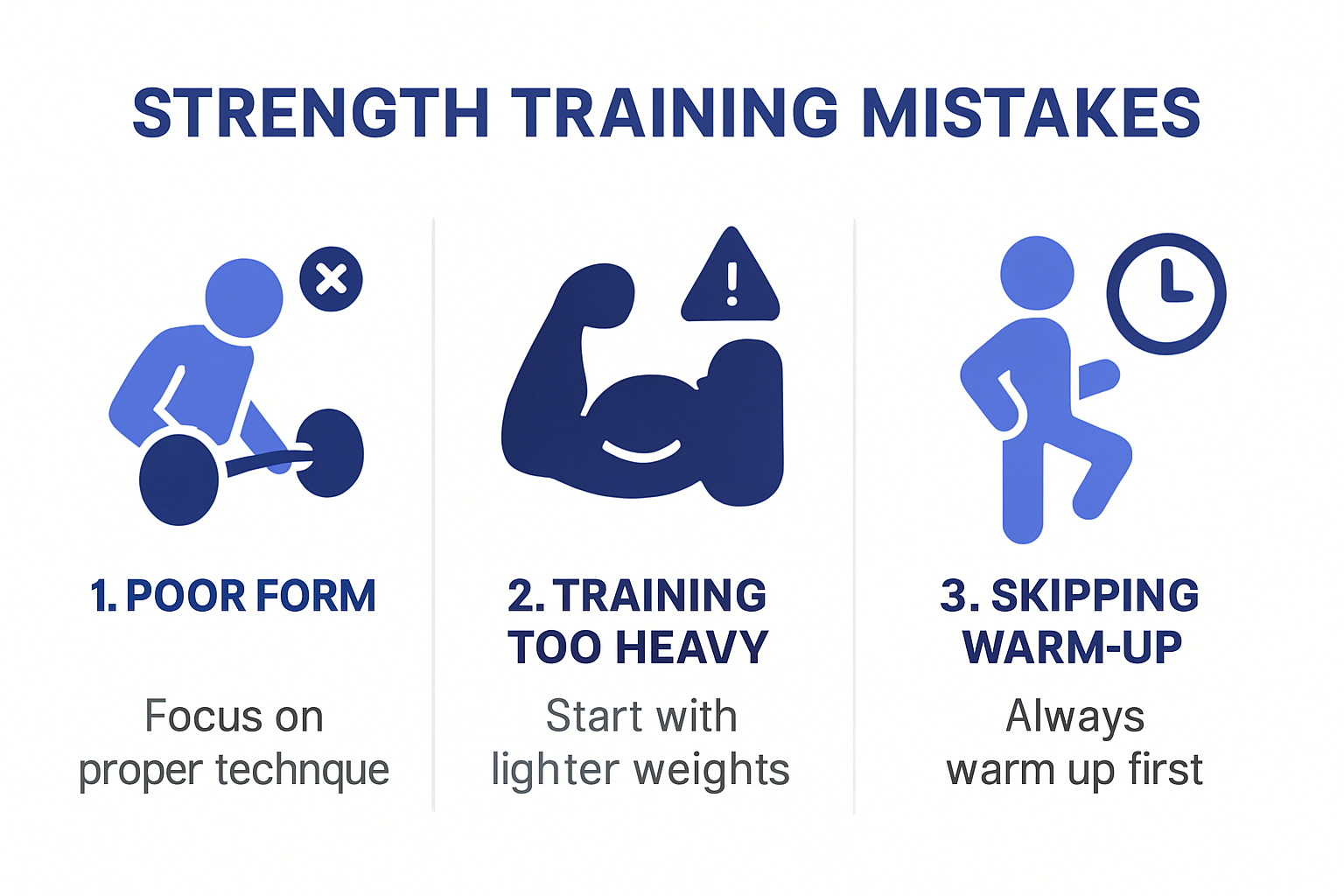Strength training is often celebrated for building muscle, but people rarely talk about its fat-burning power. Most folks still assume endless cardio is the only way to shed pounds.
The truth is, strength training can raise your resting metabolic rate and help you burn more calories around the clock.
In fact, for every pound of muscle you add, you can burn an extra 6 to 10 calories per day even when you are not working out.
Think lifting weights is just for bodybuilders? Think again. Muscle turns your body into a 24-hour calorie-burning machine, changing the game for anyone serious about long-term weight loss.
Table of Contents
- Why Strength Training Supports Weight Loss
- Best Strength Training Exercises For Fat Loss
- How To Create A Strength Training Routine
- Tips For Success And Common Mistakes To Avoid
Quick Summary
| Takeaway | Explanation |
|---|---|
| Strength training boosts metabolism. | Building muscle increases resting metabolic rate, allowing for more calories burned at rest. |
| Compound movements are essential. | Exercises like squats and deadlifts engage multiple muscle groups, maximizing fat burn and efficiency. |
| Progressive overload is crucial for success. | Gradually increasing weights and resistance ensures continued muscle challenge and prevents plateaus. |
| Adequate recovery is vital for progress. | Proper nutrition and rest contribute significantly to muscle development and overall strength gains. |
| Track multiple metrics for motivation. | Use various indicators like strength improvements and body measurements to gauge progress beyond just weight. |
Why Strength Training Supports Weight Loss?
Strength training goes far beyond building muscle definition. It is a powerful metabolic strategy that transforms how your body processes energy and burns fat.
Unlike traditional cardio approaches that primarily focus on immediate calorie expenditure, strength training creates a comprehensive metabolic environment that supports sustainable weight loss.
Muscle Mass and Metabolic Boost
Building muscle through resistance training significantly impacts your metabolic rate. Research from Harvard T.H. Chan School of Public Health reveals that muscle tissue is metabolically active, meaning it burns calories even when you are at rest.
For every pound of muscle gained, your body can burn an additional 6-10 calories per day. While this might seem minimal, over time these incremental increases compound dramatically.
A comprehensive review published in the National Institutes of Health highlights that resistance training not only increases lean muscle mass but also preserves metabolic rate during weight loss phases.
This is crucial because many traditional dieting methods can cause metabolic slowdown, making future weight loss increasingly difficult.
Hormonal and Metabolic Adaptations
Strength training triggers profound hormonal responses that support fat loss. When you engage in resistance exercises, your body releases hormones like testosterone and growth hormone, which play critical roles in muscle development and fat metabolism.
These hormonal changes create an optimal internal environment for burning stored fat and preventing new fat storage.
Moreover, strength training improves insulin sensitivity.
By enhancing how effectively your body manages blood sugar, you reduce the likelihood of excess glucose being converted and stored as fat. Learn more about muscle development strategies to maximize these metabolic benefits.
Long-Term Weight Management Strategy
Unlike quick-fix cardio routines, strength training provides a sustainable approach to weight management. As you build muscle, your resting metabolic rate increases, meaning you burn more calories throughout the day without additional effort.
This metabolic adaptation ensures that weight loss becomes a continuous process rather than a temporary achievement.
Strength training also helps prevent the metabolic slowdown commonly experienced during prolonged weight loss efforts. By maintaining and building muscle mass, you keep your metabolism active and responsive.
This approach shifts the focus from simply losing weight to transforming body composition, resulting in a leaner, more metabolically efficient physique.
The key is consistency and progressive overload. Start with manageable weights and gradually increase resistance to continually challenge your muscles and metabolic systems.
Remember, strength training is not just about losing weight but about creating a healthier, more resilient body.
Best Strength Training Exercises for Fat Loss
Strength training for weight loss requires a strategic approach that targets multiple muscle groups and maximizes metabolic engagement. Not all exercises are created equal when it comes to burning fat and building lean muscle.
The most effective strength training routines combine compound movements that challenge multiple muscle groups simultaneously and elevate your overall energy expenditure.
Compound Movements for Maximum Fat Burn
Compound exercises are the gold standard for fat loss. Research from the National Institutes of Health emphasizes that multi-joint movements significantly increase lean muscle mass and metabolic rate. These exercises engage multiple muscle groups, creating a more comprehensive and efficient workout strategy.
Key compound exercises include:
- Squats: Engage your entire lower body and core, burning substantial calories while building leg and glute strength
- Deadlifts: A full-body movement that targets back, legs, and core muscles
- Bench Press: Develops chest, shoulder, and arm muscles while increasing overall upper body strength
- Pull-ups: Challenging bodyweight exercise that works back, arms, and core muscles
Explore advanced compound lifting techniques to maximize your fat loss potential and muscle development.
Progressive Resistance and Muscle Activation
To effectively lose fat through strength training, progressive overload is crucial. This means gradually increasing the weight, frequency, or number of repetitions in your strength training routine.
Progressive resistance ensures your muscles are continuously challenged, preventing plateaus and maintaining metabolic efficiency.
Beginners should start with lighter weights and focus on proper form. As strength improves, incrementally increase resistance to continue challenging muscle groups.
This approach not only supports fat loss but also builds functional strength that translates into everyday activities.
Strategic Workout Design
Effective fat loss through strength training requires more than just selecting the right exercises. Workout design plays a critical role in metabolic activation.
Incorporate techniques like circuit training, where you move quickly between different strength exercises with minimal rest. This approach keeps your heart rate elevated and maximizes calorie burn during and after the workout.
Consider alternating between upper and lower body exercises to maintain muscle engagement and prevent fatigue. A well-designed strength training program might include 3-4 sessions per week, targeting different muscle groups and allowing adequate recovery time.
Remember that consistency is key. While these exercises are powerful for fat loss, they must be performed regularly with proper technique and combined with a balanced nutrition plan.
Strength training is not just about losing weight but transforming your body composition and building a stronger, more metabolically active physique.
How to Create a Strength Training Routine?
Developing an effective strength training routine requires strategic planning and a comprehensive understanding of your fitness goals. Unlike generic workout programs, a personalized approach ensures sustainable progress and prevents plateaus in your weight loss journey.
The key is creating a balanced, progressive plan that challenges your muscles while allowing adequate recovery.
Fundamental Workout Structure
The National Institute of Diabetes and Digestive and Kidney Diseases recommends engaging in strength training at least two days per week, targeting all major muscle groups.
A well-designed routine should include exercises for legs, hips, chest, back, abdomen, shoulders, and arms. Beginners should focus on mastering proper form before increasing weights or complexity.
A basic weekly structure might look like:
- Monday: Full body workout focusing on compound movements
- Tuesday: Rest or light cardio
- Wednesday: Upper body strength training
- Thursday: Rest
- Friday: Lower body and core exercises
- Weekend: Active recovery or optional light training
Learn more about developing muscle-specific training strategies to optimize your routine.
Progressive Overload and Exercise Selection
According to the Centers for Disease Control and Prevention, adults should aim for 150 minutes of moderate-intensity aerobic activity combined with two days of muscle-strengthening activities.
Progressive overload is crucial in this approach. This means gradually increasing the weight, repetitions, or sets to continually challenge your muscles.
When selecting exercises, prioritize:
- Compound movements that engage multiple muscle groups
- Exercises that match your current fitness level
- Movements that can be performed with proper technique
- Variations that prevent boredom and muscle adaptation
Technique and Safety Considerations
The Mayo Clinic emphasizes the critical importance of proper form to prevent injury and maximize effectiveness. Before adding significant weight, focus on mastering movement patterns.
Consider working with a qualified fitness professional who can assess your technique and provide personalized guidance.
Key safety tips include:
- Warm up before each session
- Start with lighter weights
- Maintain proper posture
- Listen to your body and avoid pain
- Allow 48 hours of recovery between training the same muscle groups
Remember that consistency trumps intensity.
A sustainable strength training routine is one you can maintain long-term. Adapt your program as you progress, always prioritizing proper form, gradual progression, and overall body balance.
Your routine should evolve with your increasing strength and changing fitness goals.
>>> Check Out How I Regained My “Slim Figure” by Drinking “Fat Loss Smoothies” at Home <<<
Tips for Success and Common Mistakes to Avoid
Successful strength training for weight loss requires more than just showing up at the gym. It demands a strategic approach, mental resilience, and an understanding of potential pitfalls that can derail your progress.
Research published in Current Sports Medicine Reports emphasizes that sustainable fat loss through strength training hinges on consistent, intelligent implementation of exercise strategies.
Nutrition and Recovery Strategies
Perhaps the most critical aspect of strength training success is understanding that muscle development and fat loss happen outside the gym. Proper nutrition and recovery are foundational to achieving your goals.
Adequate protein intake is crucial for muscle repair and growth. Aim for approximately 1.6 to 2.2 grams of protein per kilogram of body weight daily, spread across multiple meals.
Recovery involves more than just rest. Quality sleep, hydration, and active recovery techniques play significant roles in muscle adaptation and metabolic efficiency.
Aim for 7-9 hours of sleep per night and incorporate strategies like foam rolling, gentle stretching, and low-intensity movement on rest days.

Explore comprehensive weight loss strategies to complement your strength training approach and maximize results.
Common Mistakes to Avoid
Many individuals sabotage their strength training efforts through predictable mistakes. The most prevalent errors include:

- Inconsistent Training: Sporadic workouts prevent muscle adaptation and metabolic improvements
- Neglecting Progressive Overload: Failing to gradually increase weight or resistance
- Poor Form: Compromising technique to lift heavier weights increases injury risk
- Overtraining: Not allowing sufficient recovery between intense sessions
- Ignoring Nutrition: Believing exercise alone will drive weight loss
Beginners often become discouraged when immediate results are not visible. Understanding that body composition changes occur gradually is crucial for long-term motivation. Muscle gain and fat loss are subtle processes that require patience and consistent effort.
Mental Approach and Sustainable Progress
Psychological resilience is as important as physical technique in strength training. Set realistic, measurable goals and track progress through multiple metrics beyond just body weight. Consider tracking body measurements, progress photos, strength improvements, and how your clothing fits.
Develop a growth mindset that views challenges as opportunities for improvement. Understand that plateaus are normal and do not indicate failure. When progress stalls, it might signal the need to adjust your routine, reassess nutrition, or introduce new training variations.
Remember that strength training is a skill that improves with practice. Each workout is an opportunity to learn about your body, refine your technique, and build a stronger, more resilient physique. Embrace the journey, celebrate small victories, and maintain a long-term perspective on your fitness transformation.
Frequently Asked Questions
A quick look at each of these in brief:
What are the benefits of strength training for weight loss?
Strength training not only helps build muscle but also boosts your metabolism, enabling your body to burn more calories at rest. Each pound of muscle gained increases your daily calorie expenditure by about 6 to 10 calories.
How can I design an effective strength training routine for weight loss?
A well-structured routine should include at least two days of strength training per week targeting all major muscle groups. Incorporate compound movements, such as squats and deadlifts, for maximum fat burn and consider progressive overload to challenge your muscles continuously.
What common mistakes should I avoid when strength training for weight loss?
Common mistakes include inconsistent training, neglecting progressive overload, poor form, overtraining, and ignoring nutrition. To see sustainable results, it’s essential to maintain consistent workouts and proper dietary habits.
How important is nutrition and recovery in a strength training program for weight loss?
Nutrition and recovery are crucial for muscle development and fat loss. Adequate protein intake, quality sleep, and hydration play significant roles in supporting your strength training efforts and overall fitness goals.
Ready to Turn Strength Training Into Real Weight Loss Results?
Building muscle and burning stubborn fat is not easy, especially if you feel overwhelmed by conflicting advice and slow progress. If you have struggled with plateaued results or worry your workouts are not as effective as they could be, you are not alone.
This article showed that compound strength exercises, metabolic boosts, and smart recovery strategies are game-changers. But even with motivation, getting a practical, step-by-step plan can make all the difference.
You deserve an approach that makes strength training simple and rewarding while helping you avoid common mistakes.
Check out our proven strength training methods for weight loss and get real-world tips on building muscle, burning fat, and staying consistent.

Take charge of your fitness goals today. Visit leanandfit.info for expert resources, tailored exercise regimens, and ongoing support. Do not let another week go by without seeing progress.
Explore Exercise Regimens and discover how the right routine can help you lose weight and transform your body. Your next step to lasting results starts here.